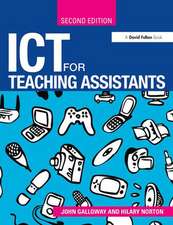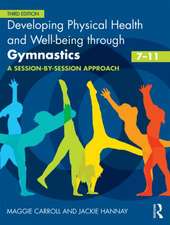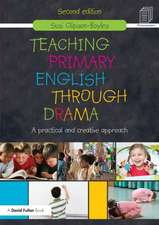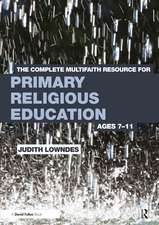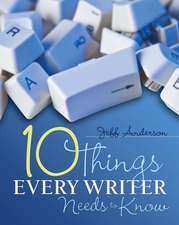Well Played, Grades K-2: Building Mathematical Thinking Through Number Games and Puzzles
Autor Linda Dacey, Karen Gartland, Jayne Bamford Lynchen Limba Engleză Paperback – 23 noi 2015
Preț: 279.83 lei
Nou
Puncte Express: 420
Preț estimativ în valută:
53.56€ • 58.20$ • 45.02£
53.56€ • 58.20$ • 45.02£
Carte tipărită la comandă
Livrare economică 21 aprilie-05 mai
Preluare comenzi: 021 569.72.76
Specificații
ISBN-13: 9781625310347
ISBN-10: 162531034X
Pagini: 222
Dimensiuni: 203 x 254 x 13 mm
Greutate: 0.5 kg
Ediția:1
Editura: Taylor & Francis
Colecția Routledge
Locul publicării:Oxford, United Kingdom
ISBN-10: 162531034X
Pagini: 222
Dimensiuni: 203 x 254 x 13 mm
Greutate: 0.5 kg
Ediția:1
Editura: Taylor & Francis
Colecția Routledge
Locul publicării:Oxford, United Kingdom
Public țintă
Professional Practice & DevelopmentRecenzii
“This is a book full of thoughtful and well-chosen games and puzzles, but it is also a book that offers a lens into how we might include this kind of play in our own classrooms in ways that are deeply meaningful and engaging for our students. It is a book truly rooted in the realities and possibilities of the classroom, which is what makes it such a valuable resource for teachers.” – Kassia Omohundro Wedekind, from the foreword
Are you looking for a way to add mathematically rich games to your students’ problem solving? Dacey, Gartland, and Lynch provide a valuable resource for K–grade 2 educators to plan and implement puzzles and games. The authors begin by offering principles and guidance for implementation of games and puzzles in the classroom, based on their classroom experiences, field testing, and on research. The remaining chapters each present games, some familiar, some less common, on topics including counting and ordering, base-ten numeration, addition, and subtraction.
For use as a curriculum component or supplement, the book includes good attention to implementation and assessment as well as offering good examples, sample exit questions, suggestions for differentiation of games, options for directions and game variations, and consideration of students’ reading levels. A unique asset is guidance on students’ “manners,” norms for interaction, keeping the focus on the mathematics rather than secondary to superficial aspects or winning. A few minor modifications would have made the book an even stronger resource: additional guidance on assessment, such as a few example rubrics, clarifications to a few transcripts, and additional direction on creating cards or game boards to extend, differentiate, and vary the games. Consider teaming up with colleagues to analyze a game; then pilot it with a group of students before building a lesson or center around it.
Educators planning K–grade 2 mathematics learning will find Well Played to be conceptually, developmentally, and pedagogically strong—as well as fun and engaging—for their schools.
—Lucia M. Flevares, independent mathematics education consultant, Columbus, Ohio.
Are you looking for a way to add mathematically rich games to your students’ problem solving? Dacey, Gartland, and Lynch provide a valuable resource for K–grade 2 educators to plan and implement puzzles and games. The authors begin by offering principles and guidance for implementation of games and puzzles in the classroom, based on their classroom experiences, field testing, and on research. The remaining chapters each present games, some familiar, some less common, on topics including counting and ordering, base-ten numeration, addition, and subtraction.
For use as a curriculum component or supplement, the book includes good attention to implementation and assessment as well as offering good examples, sample exit questions, suggestions for differentiation of games, options for directions and game variations, and consideration of students’ reading levels. A unique asset is guidance on students’ “manners,” norms for interaction, keeping the focus on the mathematics rather than secondary to superficial aspects or winning. A few minor modifications would have made the book an even stronger resource: additional guidance on assessment, such as a few example rubrics, clarifications to a few transcripts, and additional direction on creating cards or game boards to extend, differentiate, and vary the games. Consider teaming up with colleagues to analyze a game; then pilot it with a group of students before building a lesson or center around it.
Educators planning K–grade 2 mathematics learning will find Well Played to be conceptually, developmentally, and pedagogically strong—as well as fun and engaging—for their schools.
—Lucia M. Flevares, independent mathematics education consultant, Columbus, Ohio.
Notă biografică
Linda Dacey, consultant and professor emeritus at Lesley University, has always believed that learning mathematics should be conceptually based and enjoyable. Her major interests are problem solving, number sense, and strategies for differentiation. Linda is the coauthor with Anne Collins of the Zeroing in on Number and Operations series, as well as other titles focused on teaching mathematics at the K-2 level.Karen Gartland is a mathematics coordinator and classroom teacher at Groton-Dunstable Middle School. She enjoys working with students of all ages with a focus on conceptual understanding of mathematics through critical thinking and application as well as best practices for integrating technology. Karen is also an adjunct faculty member at Lesley University. Jayne Bamford Lynch is a district math instructional coach in Cambridge, Massachusetts, where she spends most of her days in elementary classrooms supporting coaches, teachers, and students. Jayne presents workshops for teachers, administrators, and parents on a multitude of topics and is also a National Faculty member of the School of Education at Lesley University.
Cuprins
Chapter 1: Introduction; Chapter 2: Supporting Learning Through Games and Puzzles; Chapter 3: Counting and Ordering; Chapter 4: Base Ten Numeration; Chapter 5: Addition; Chapter 6: Subtraction; Chapter 7: Addition and Subtraction
Descriere
Students love math games and puzzles, but how much are they really learning from the experience? Too often, math games are thought of as just a fun activity or enrichment opportunity.



